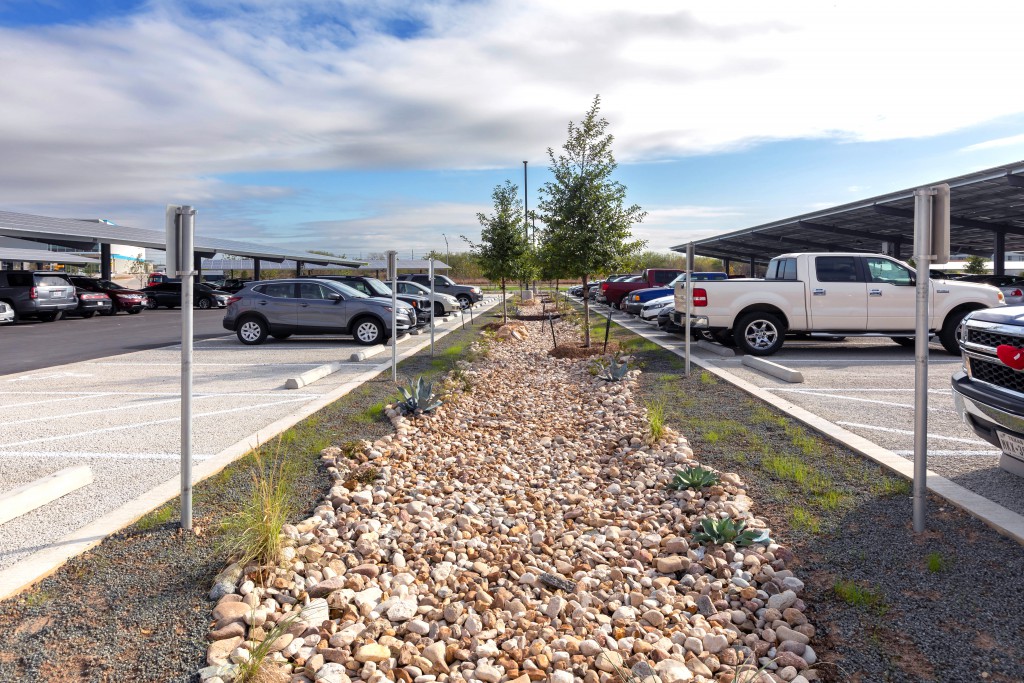Environmentally conscious construction sites have earned praise over the years as the world’s priorities have shifted to address growing climate concerns.
The World Green Building Council (GBC) estimates the building and construction sector is globally responsible for 50% of the world’s resource consumption, 36% of energy consumption and 38% of energy-related carbon emissions. Keeping this in mind, any time a building or facility can feature sustainable design, it’s a win for the planet.
Expectations are changing, however. What was once seen as the “cherry on top” of a construction project is quickly becoming standard practice.
A prime example of this is the evolution of the use of low-impact development (LID).
What is low-impact development?
Low-impact development (LID) is an approach to stormwater management intended to preserve water quality, conserve stormwater runoff and protect the local ecosystem.
The engineering strategy incorporates the natural environment into the site design as a stormwater management tool while conserving natural areas and minimizing the development impact on hydrology.
LID requirements are becoming increasingly commonplace
LID isn’t a groundbreaking, new principle.
For years, Section 438 of the Energy Independence and Security Act of 2007 has required all federal government facilities to incorporate LID. The U.S. Green Building Council (USGBC) has also placed emphasis on LID over the years by making it a requirement for buildings and constructions pursuing LEED certification — a topic we’ve explored in this blog.
However, what is new is the rate at which we are seeing local governments include and tighten LID requirements in their land development codes. Part of this shift is driven by the U.S. Environmental Protection Agency (EPA) pressure for local entities to review and revise their codes to amend obstacles to LID practices.
Circling back to my earlier point — expectations are changing. Green infrastructure is no longer the exception, but becoming the standard.
Take, for example, Stellar’s award-winning Cuisine Solutions plant in Texas. While it’s true obtaining LEED (Leadership in Energy and Environmental Design) certification was always a goal for the design-build project, much of the groundwork that led us to accomplish that objective was set by the City of San Antonio’s land development codes. The state-of-the-art facility’s eco-friendly design solutions, including its LID approach using bioswales and pervious concrete for parking spaces, earned it recognition as Food Engineering magazine’s 2021 Sustainable Plant of the Year.
Stellar’s engineering team found themselves navigating similar circumstances while working on a new refrigerated distribution facility in Tampa for Caspers Cold Storage & Distribution in 2018. Hillsborough County’s highly regulated permitting process required the facility to work around wetlands located on the site. As a result, the final design needed to be mindful of sensitive wetland protection while also meeting Florida’s building codes and stormwater management requirements as a hurricane-prone area.
A cost-effective alternative for companies
Sustainable stormwater management plays a significant role in conservation efforts — but it’s not just the planet that stands to gain from incorporating green elements. LID can prove to be fiscally beneficial for companies, too.
In fact, nationwide EPA case studies found LID methods to be more economical than conventional stormwater practices in most cases, with total capital cost savings ranging from 15% to 80%.
According to the federal agency, some of the low-cost elements they observed in these cases include:
- Lower costs associated with stormwater management and flood control compared to traditional methods. This is accomplished by increasing the amount of natural areas on a site to help reduce the amount of runoff generated.
- Reducing costs associated with combined sewer overflows by using bioswales to encourage rainwater to “soak into the ground rather than allowing it to run into storm drains.
5 ways to incorporate LID techniques in your facility
There are many ways to incorporate LID techniques into your design-build and renovation projects. To get you started, here are some commonly used strategies to consider for your next facility:
- Bioswales — Bioswales are an alternative to storm sewers that collect stormwater runoff and filter it, often using plants and soils. The gently sloping vegetation removes debris and pollutants from water while redistributing it to allow for ground absorption.
- Bioretention — Bioretention areas help improve water quality by catching stormwater runoff and using soil and plant-based filtration devices to remove pollutants before they infiltrate the ecosystem. They are often used in conjunction with bioswales.
- Native (local) landscape — Native vegetation can be used strategically to manage stormwater drainage and preserve water quality at a site without the need for supplemental irrigation or fertilizers.
- Pervious pavement — Pervious pavement is high-porosity concrete designed to allow rainwater to seep through the surface down to the soil. It can help reduce runoff, as well as filter out water pollutants.
- Cisterns and rain barrels — Cisterns and rain barrels are used to collect rainwater for reuse and reduce stormwater runoff.
Ready to find out how to incorporate low-impact development into your next project? Reach out to me at foodforthought@stellar.net.



